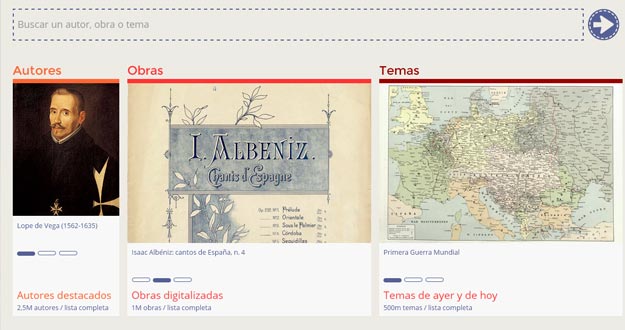I have just seen an interesting news about our Spanish Culture: “The National Library debuts a more intuitive online catalog”.
I am glad, knowing that the people responsible of this new catalog is able to move the Spanish Culture closer to people interested on it.
The National Library of Spain (BNE) already has a new online portal, for access to its data catalog, which aims to explore the bibliographic information, with a different approach to traditional, based on techniques of linked data.

Screen shot of the new data portal of the National Library of Spain
That is, the application provides a search and retrieval broader intuitive and understandable than that obtained with the current systems, as recorded Sync (a journal about Science).
The portal, developed by members of the Ontological Engineering Group of the Polytechnic University of Madrid (PUM), integrated access to resources, that were previously independent (authorities, digital library and index), in a single application and enrich them, with data from other libraries.
The portal datos.bne.es has, as objective public, suchthe user of the library as the computer specialist. The second one will find a database, described in semantic language, that can be reused in other applications.
To do this, the bibliographic data of authors, works and themes have been transformed, from the traditional architecture of libraries, in certain formats (MARC21), to models and structures of the semantic web using the called Marimba tool.
Portal users find an interface, that exploits the data relationships and experiment, with new ways of presentation. Moreover, they can access to those copies, that are digitized, from the Hispanic Digital Library. Improvements also include the expansion of data offered, as much bibliographic as authority records.
With this technology, data can be displayed, on the website, of a reusable way --so that, other users can give them new uses-- and in a format that allows to operate with other applications. So, it exploits the relationships, between BNE own data and external data from other institutions.
The development allows the BNE join the challenge, to publish its bibliographic and about authorities catalogs, in RDF (Resource Description Framework) format, according to the principles of linked data, both basic components, in the semantic web.
Thus, it is adhered to the initiatives of other large national libraries, in France, UK, Germany and USA. Furthermore, intellectual property license, applied to data, is Creative Commons, to promote reuse and move closer to citizens.
From late November 2014 to late February 2015, it has been doubled the number of daily visits, to a total of over 40,000 unique visitors and over 155,000 visited pages.
The Ontology Engineering Group, led by the Professor Asunción Gómez Pérez (who has just received the “Ada Byron Woman Technologist Award 2015”, awarded by the University of Deusto), is located in the High Technical School of Computer Engineering, at the PUM.
Its researchers have developed applications, in a wide range of domains, such as knowledge management, life cycle management software applications, technological surveillance, text annotation and medical records, sentiment analysis, ecommerce, job searches and funding, geolocation and management of R + D projects.
In the field of linked data, emphasise, besides the application for the BNE, developed by doctoral student, Daniel Vila, the work done, in collaboration with the National Geographic Institute (GeoLinkedData), the Meteorological Agency (AEMET), the Grupo Prisa Digital (the Traveller), the Regional Transport Consortium Madrid and Fundeu (Terminesp).
In addition, this group maintains the Spanish chapter of DBpedia (project for the extraction of data from Wikipedia, with the aim of creating a semantic web version) and it participates in various activities of W3C standards (international consortium, that produces recommendations for the World Wide Web ).
Well, as I said, at the beginning, I think this project is a great discovery, in order to release our Spanish cultural heritage. I hope that many people can enjoy it.
Until my next post, kind regards,
Luis.
Sponsored by Costaluz Lawyers.
Please click below:
